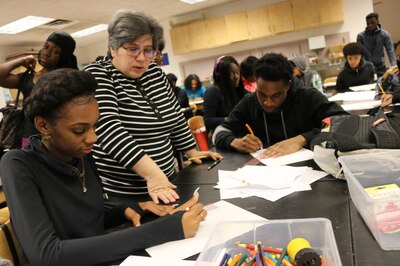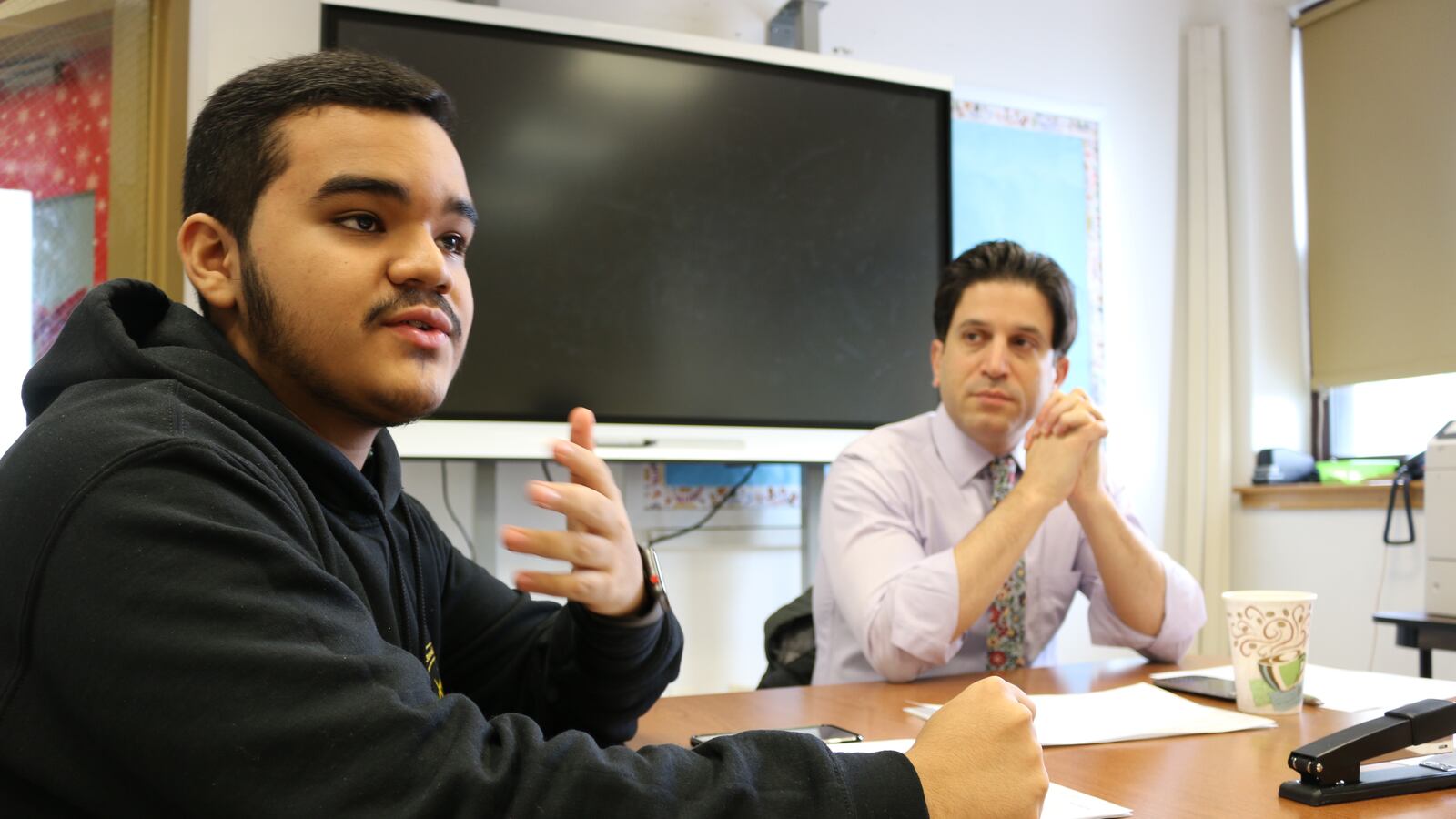On a recent January morning, students Galeel Cora and Jenitza Jack sat in a conference room at Brooklyn High School for Law and Technology — a school that’s a 30 minute bus ride from the one they attend.
They came seeking advice on how their school, Brooklyn Community Arts & Media, can provide more opportunities for students to explore the themes promised by its name. They had the seed of a solution — a proposed event called “Fresh Fridays,” which would showcase students’ talents in painting, rap, dance, and other creative endeavors — but they weren’t sure how to get it off the ground.
The administrator they met with, Law and Tech Assistant Principal Melanie Werner, had plenty of ideas.
Maybe the event should be styled after a “gallery walk,” with each different classrooms featuring a different art medium, she suggested. The students nodded in agreement. Go after grants to fund it, she added. Galeel jotted that down. Reach across social cliques to recruit students to both contribute art and show up to the event, Werner offered.
“Get some kids together and come up with a game plan,” she said. “But it has to be fun, or it’s going to lose steam.”
The students were gathering this advice through a program called the Student Voice Collaborative, which trains students to analyze issues at their schools and come up with solutions. One important way they do that is by visiting partner schools — an approach to school improvement that Chancellor Carmen Fariña has also championed through similar programs that promote cross-campus collaboration among adults.
Launched in 2010 and run out of the Brooklyn North Field Support Center, the collaborative aims to add student voices to the mix. Equal parts research project, internship, and civics lesson, the program now spans seven districts and includes about 10 schools each year.
“A lot of times students aren’t involved in these types of conversations,” said Lisandro Mayancela, a senior at Law Tech. “You’re coming up with decisions that will affect the kids the most, so why not give those students a chance to sit down [and] actually voice their opinions?”
Students at each participating school are paired with groups from a different school through surveys and a speed-dating-style event at the start of the year. Then the teams meet every other week to discuss issues at their respective schools and brainstorm solutions. Students are also matched with an “action team” of adults at their own school, who help the students zero in on challenges and then follow through on their school-improvement ideas.
“We try to develop structures that promote youth-adult partnership, so the action team is like the heart” of the program, said Ari Sussman, an official at the support center who launched the collaborative. “Students and adults put their priorities side by side.”
One of the program’s highlights comes about halfway through the year when students take turns visiting and hosting partner schools. For Galeel and Jenitza, that meant taking an early morning bus ride to Law Tech to look for lessons to bring back to their own school.
During their visit, they dropped in on an art class and had a long discussion over pizza with Law Tech’s Student Government representatives, who shared how how they’ve managed to make their school events a success — tips for Galeel and Jenitza to keep in mind as they try to build Fresh Fridays. One Law Tech student suggested recruiting freshman, who would be too green to remember past school events that may have been boring. Another said good music would draw people in — and so would a little positive peer pressure, like a direct invite for popular students who hold sway with the rest of the school.
“I know for a fact that if a popular student is going to a party, I’m going, too,” he said.
They also met with art teacher Maria Pascual, who noted the funding challenges that Brooklyn Community Arts & Media is likely to face if it tries to adhere more closely to its theme. To illustrate her point, she mentioned that students have a hard time drawing on her school’s outdated iPads. Some funding riddles, she said, require creative solutions.

“Everybody in your school has a phone,” she told the visiting students as she whipped out her own cell phone and dragged her finger across the screen. “Get your teacher to download a sketchbook, and they can draw on their phones… Start thinking about, ‘What can I do right now.’”
While the program can help students come up with policy ideas, it’s up to their school leaders to give their ideas due consideration and carry them out.
One school that has done that is the Academy for Young Writers in Brooklyn, which was part of the Student Voice Collaborative last year.
After students in the program noticed that 9th-graders’ attendance and grades had taken a nosedive midyear, the principal hosted regular strategy meetings in his office where he and the students could brainstorm solutions. Once they decided to try pairing the freshmen with 11th-grade mentors, the team’s faculty advisor, English teacher Michelle Eisenberg, agreed to train the older students.
By the end of the school year, the 9th-graders’ academics and attendance had stabilized, Eisenberg said. The students’ mentoring idea seemed to have made a difference — but only because the administration took it seriously.
“It’s one thing to invite a group of students to sit down one time and hear what they have to say,” she said. “I think it’s another thing to have students sit down in the principal’s office once a week, being critical and being proactive.”

